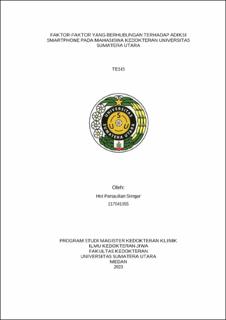| dc.description.abstract | Background: Smartphones have become important devices in everyday life in recent years, scientific encouragement and the extraordinary evolution of technology have resulted in having to provide information in all subjects anytime and anywhere. The popularity of smartphones among the younger generation has increased as a means of keeping in touch with others and seeking out all they can. Excessive use of being informed can lead to health hazards such as decreased academic success and social participation in real life, headaches, neck pain, fatigue, distraction. sleep, memory loss, hearing loss and decreased concentration. Repetitive individual behaviors create a need to evaluate situations in terms of addiction if they affect functionality in daily life and social relationships.
Method: This research is a predictive type multivariate study with a cross-sectional approach. The sampling technique in this study used a non-probability sampling technique with purposive sampling. The research was conducted from November 2022 to January 2023 involving 200 students of the Faculty of Medicine, University of North Sumatra. The data begins by filling in demographic data and the smartphone addiction scale short Indonesian version (SAS-SV). After the results are obtained, management and data analysis will be carried out using SPSS software. Linear regression is used when all the required conditions are met.
Result : Independent factors such as gender, age, operating system, internet access, parental income, duration of use and duration of sleep were found to be associated with the SAS-SV score with p<0.05 and R2=62.8% (indicating that the independent factors were related with a SAS-SV score of 62.8%). On the other hand, we found that independent factors, such as education level and other smartphone functions, were not statistically significant (p>0.05). Therefore, these factors are not related to SAS-SV scores.
Conclusion : In medical students at the University Sumatera Utara, this study found that the independent risk factors associated with SAS-SV scores in medical students during a pandemic were as follows; gender, age, operating system, internet access, parental income, usage duration and sleep duration. | en_US |


